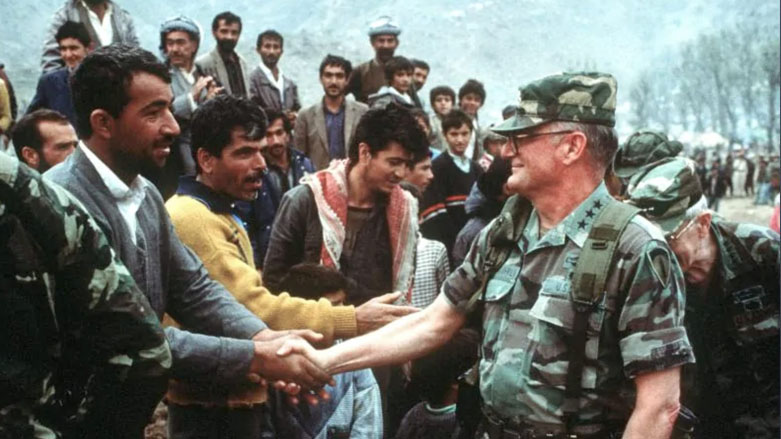No fly zone: the pillar of Iraqi Kurds’ survival
Aid from the Kurds’ international friends led to the creation of the Kurdistan Region

ERBIL (Kurdistan 24) – For most of the Kurds in what is now the Kurdistan Region of Iraq, the no-fly zone is a synonym for peace and security in a region, where bloody conflicts are imminent at any moment, particularly for a stateless Kurdish nation.
Following the popular uprising against Baathist institutions in the Kurdish provinces in Iraq, the Kurds felt for a moment they toppled a regime that had attempted to ethnically erase them through what are now notorious means, including gassing thousands of people in a single hour in late 1980.
Prior to that mass murder, the Iraqi regime launched an eight-stage campaign in the mountains and peripheries of the Kurdish provinces to depopulate these areas of any Kurds, in what has been dubbed the Anfal campaigns. Hundreds of thousands of villages were destroyed by bulldozers as their inhabitants flocked into refugee camps.
A short period of euphoria ended after the uprising when Kurds soon learnt that Iraqi regime forces had launched attacks to reclaim those areas it had lost to the Kurdish civilians and Peshmerga forces in the revolt. The wave of nearly half a million Kurds towards the Iranian and Turkish borders began as the tragic memories of the Halabja chemical attack and Anfal campaign, topped by the regime’s brutality, were still fresh in the minds of the traumatized fleeing masses.
Trapped at the gates to Iraq’s two neighboring countries, the Kurds were continuing to witness tragedies as many children, elderly and people with medical conditions succumbed to death in the freezing cold of the border towns, awaiting a helpful hand from anyone.
Like a miracle, an international coalition launched not a military operation, but one to deliver food and medical aid to the starving and sick Kurds trapped in the mountains, a mission dubbed Operation Provide Comfort.
The operation began in April 1991 and ended in mid-July. The fear of abandonment was felt by the Kurds as the international forces signaled their plan to end the effort, which had formed a tiny safe haven for the Kurds from Bathist aggression.
After the forces pulled out in the summer, a small part of the coalition remained and a no-fly zone was established to protect the vulnerable from any potential air attack by the regime.
UN Security Council Resolution 688
In the minds of the Kurds and their friends, the United Nations Security Council resolution 688 approved on April 5, 1991 was the cornerstone for what is now the autonomous Kurdistan Region in Iraq. The resolution adopted by the permanent Security Council members demanded the end of oppression against the Kurdish civilians of Iraq, and opened a humanitarian corridor to deliver vital aid to the Kurdish refugees.
This necessary support and aid from the Kurds’ international friends led to the creation of the first Kurdish government in Iraq in 1992, through a democratic election to form the Kurdistan Regional Government which stands today. The Kurdistan Parliament later recognized the suffering of its people as an act of genocide by the Iraqi regime.
Editor’s Note: April 5, 2021 marks the 30th anniversary of UN Security Council Resolution 688, which demanded a safe haven for the Kurdish people and other Iraqis persecuted by Saddam Hussein’s government. The resolution did not itself call specifically for a no-fly zone but laid the foundation for France, the United Kingdom, and United States to establish no-fly zones, and to the eventual formation of the autonomous Kurdistan Region.
Editing by Joanne Stocker Kelly